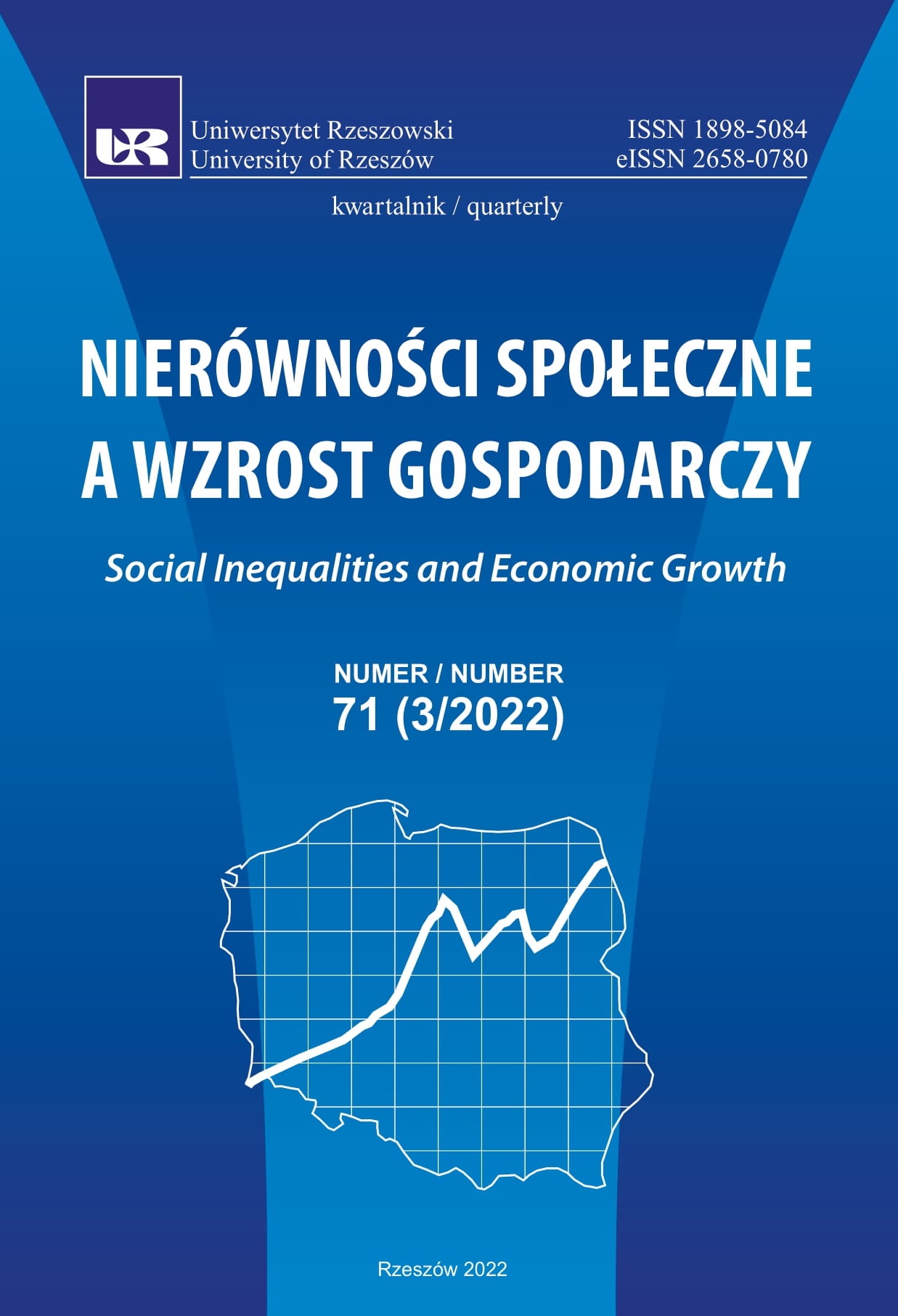Wpływ pandemii COVID-19 na poziom wykluczenia finansowego mieszkańców południowo-wschodniego regionu Polski
DOI:
https://doi.org/10.15584/nsawg.2022.3.5Słowa kluczowe:
wykluczenie finansowe, COVID-19, pandemia, województwo podkarpackieAbstrakt
Głównym celem prowadzonych badań była ocena wpływu kryzysu pandemicznego na poziom wykluczenia finansowego mieszkańców południowo-wschodniego regionu Polski oraz identyfikacja czynników determinujących wykluczenie finansowe. Szczegółowy zakres badań obejmuje obszar administracyjny województwa podkarpackiego.
Okres pandemiczny niekorzystnie wpłynął na wiele dziedzin życia społecznego i gospodarczego. Jednym z takich obszarów jest poziom wykluczenia finansowego, który w znaczący sposób dotknął osoby o niskich dochodach, często zamieszkujące wsie i małe miasteczka. Polska południowo-wschodnia, w tym województwo podkarpackie wciąż należy do słabszych gospodarczo regionów. Należy podkreślić, że województwo podkarpackie ma rolniczo-przemysłowy charakter. Odznacza się największym w skali kraju odsetkiem ludności zamieszkującej wsie (58,6%). Idąc tym tokiem rozumowania, badaniem objęto mieszkańców województwa podkarpackiego, których miejsca zamieszkania zlokalizowane są w powiatach o najniższym wskaźniku przeciętnego miesięcznego wynagrodzenia brutto w relacji do średniej krajowej oraz celem dokonania analizy porównawczej, mieszkańców największego miasta wojewódzkiego – Rzeszowa.
W badaniach zastosowano metodę sondażu diagnostycznego, a następnie odpowiedzi poddano analizie statystycznej celem obserwacji zależności pomiędzy występującymi cechami: wiek, płeć, wykształcenie etc. oraz analizie porównawczej poszczególnych powiatów. Ponadto wykorzystano metodę analizy literatury, w tym dotychczasowych badań o podobnej tematyce z okresu przed pandemią.
Na podstawie badań można stwierdzić, że osoby z wybranych do badania powiatów, zdecydowanie częściej łączą wykluczenie finansowe z brakiem zatrudnienia i niskimi zarobkami. Obawiają się o stabilność przychodów i uważają, że są wykluczone finansowo. Analogiczne zależności zaobserwowano w przypadku osób w wieku powyżej 46 lat oraz wśród osób, u których przeciętny średni dochód netto w gospodarstwie domowym przypadający na 1 osobę wynosi mniej niż 1000 zł.
Downloads
Bibliografia
Anderloni, L., Carluccio, E.M. (2007). Access to Bank Account and Payment Services. W: L. Anderloni, M.D. Braga, E. Carluccio (red.), New Frontiers in Banking Services. Emerging Needs and Tailored Products for Untapped Markets (s. 5–105). Berlin-Heidelberg: Springer-Verlag. DOI:10.1007/978-3-540-46498-3_2.
Czechowska, I.D. (2014). Innowacje finansowe na przykładzie bankowych usług dla klientów 60+. Studia Ekonomiczne, 186(1), 48–58.
Czerwiński, B. (2014). Wykluczenie finansowe starszych konsumentów na rynku usług finansowych. Marketing i Rynek, 11(CD), 336–347.
European Commission. (2008). Financial Services Provision and Prevention of Financial Exclusion, Brusselss.
Gloukoviezoff, G. (2006). From Financial Exclusion to Overindebt edness: The Paradox of Difficulties for People on Low Income? W: L. Anderleoni, M.B. Braga, E. Carluccio (red.), New Frontiers in Banking Services. Emerging Needs and Tailored Products for Untapped Markets (s. 213–245). Berlin: Springer Verlag.
Iwaszczuk, N., Jarzęcka, A. (2017). Porównanie wykluczenia cyfrowo-finansowego w Polsce i w Norwegii. Nierówności Społeczne a Wzrost Gospodarczy, 51, 204–218. DOI: 10.15584/nsawg.2017.3.17.
Kalinowski, S., Wyduba, W. (2020). Sytuacja ekonomiczno-społeczna ludności w czasie pandemii koronawirusa w Polsce. W: K. Hajder, M. Musiał-Karg, M. Górny (red.), Konsekwencje pandemii COVID-19: Państwo i społeczeństwo (s. 35–54). Poznań: UAM w Poznaniu.
Kata, R., Walenia, A. (2015). Financial Exclusion of Farmers and Rural Entrepreneurs. Journal of Agribusiness and Rural Development, 2(36), 225–235. DOI: 10.17306/ JARD.2015.24.
Kata, R., Walenia, A., Pyrkosz, D.S. (2015). Wykluczenie finansowe ludności wiejskiej w Polsce. Journal of Agribusiness and Rural Development, 4(38), 705–715. DOI:10.17306/JARD.2015.74.
Kotkowski, R., Dulinicz, M., Maciejewski, K. (2020). Zwyczaje płatnicze w Polsce w 2020 r., Raport NBP. Warszawa: NBP.
Koźliński, T. (2010). Wykluczenie płatnicze w Polsce i innych krajach UE. Raport NBP. Warszawa: NBP.
Leyshon, A., Thrift, N. (1995). Geographies of Financial Exclusion: Financial Abandonment in Britain and the United States. Transactions of the Institute of British Geographers. New Series, 20(3), 312–341. DOI: 10.2307/622654.
Maciejasz-Świątkiewicz, M. (2013). Wykluczenie finansowe i narzędzia jego ograniczania. Studia i Monografie. Uniwersytet Opolski, 488, 313–327.
Maison, D. (2010). Analiza barier dotyczących korzystania z obrotu bezgotówkowego oraz wskazanie działań ograniczających te bariery. Raport NBP, Warszawa: NBP.
Maison, D. (2012). Badanie postaw i zachowań finansowych Polaków powyżej 55 roku życia. Raport NBP. Warszawa: NBP.
Maison, D. (2013). Postawy Polaków wobec obrotu bezgotówkowego. Raport NBP. Warszawa: NBP.
Martyniuk, M. (2015). Wykluczenie finansowe a podmioty mu przeciwdziałające na przykładzie Polski. Studia Zarządzania i Finansów Wyższej Szkoły Bankowej w Poznaniu, 9, 55–71.
Prosiński, J. (2018). Determinanty wykluczenia finansowego w Polsce. Prace Naukowe Uniwersytetu Ekonomicznego we Wrocławiu, 532, 304–312. DOI:10.15611/ pn.2018.532.29.
Solarz, M. (2014). Determinanty oraz sposoby ograniczania wykluczenia finansowego osób bezrobotnych. Optimum. Studia Ekonomiczne, 4(70), 169–191. DOI: 10.15290/ ose.2014.04.70.13.
Sołtysiak, M. (2019). Empirical Analysis of the Perception of Financial Exclusion in Poland by Women. Nierówności Społeczne a Wzrost Gospodarczy, 60(4), 203–218. DOI: 10.15584/nsawg.2019.4.13.
Stańczak-Strumiłło, K. (2020). Instytucjonalne wykluczenie emerytalne w wąskim ujęciu jako rodzaj wykluczenia finansowego w Polsce. Polityki Europejskie, Finanse i Marketing, 23(72), 168–179. DOI: 10.22630/PEFIM.2020.23.72.14.
Swamy, V. (2014). Financial inclusion, gender dimension, and economic impact on poor households. World Development, 56, 1–15. DOI: 10.1016/j.worlddev.2013.10.019.
Szafrańska, M. (2013). Determinanty poziomu wykluczenia finansowego mieszkańców małopolskiej wsi. Roczniki Naukowe Stowarzyszenia Ekonomistów Rolnictwa i Agrobiznesu, 15(3), 323–327.
Warchlewska, A. (2020). Wokół istoty wykluczenia finansowego. Ujęcie przeglądowe. Finanse i Prawo Finansowe, 1(25), 123–140. DOI: 10.18778/2391-6478.1.25.08.
Ziemba, M., Świeszczak, K., Marcinkowska, M. (2014). Wykluczenie finansowe osób 50+ w kontekście dostępnej oferty bankowej. Finanse, 1(7), 145–170.
Pobrania
Opublikowane
Jak cytować
Numer
Dział
Licencja
Prawa autorskie (c) 2022 Uniwersytet Rzeszowski

Utwór dostępny jest na licencji Creative Commons Uznanie autorstwa – Na tych samych warunkach 4.0 Miedzynarodowe.


